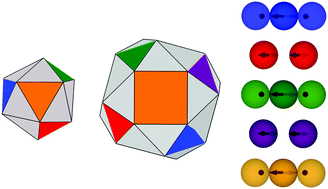Supracolloidal reconfigurable polyhedra via hierarchical self-assembly†
Abstract
Enclosed three-dimensional structures with hollow interiors have been attractive targets for the self-assembly of building blocks across different length scales. Colloidal self-assembly, in particular, has enormous potential as a bottom-up means of structure fabrication exploiting a priori designed building blocks because of the scope for tuning interparticle interactions. Here we use computer simulation study to demonstrate the self-assembly of designer charge-stabilised colloidal magnetic particles into a series of supracolloidal polyhedra, each displaying a remarkable two-level structural hierarchy. The parameter space for design supports thermodynamically stable polyhedra of very different morphologies, namely tubular and hollow spheroidal structures, involving the formation of subunits of four-fold and three-fold rotational symmetry, respectively. The spheroidal polyhedra are chiral, despite having a high degree of rotational symmetry. The dominant pathways for self-assembly into these polyhedra reveal two distinct mechanisms – a growth mechanism via sequential attachment of the subunits for a tubular structure and a staged or hierarchical pathway for a spheroidal polyhedron. These supracolloidal architectures open up in response to an external magnetic field. Our results suggest design rules for synthetic reconfigurable containers at the microscale exploiting a hierarchical self-assembly scheme.



 Please wait while we load your content...
Please wait while we load your content...